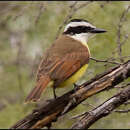en
names in breadcrumbs


Perception Channels: visual ; tactile ; acoustic ; chemical
Great Kiskadees are abundant in their wetland and woodland environments. In places like Bermuda, they are the third most common species, with population densities as high as 8 to 10 pairs per hectare. Human trade or hunting are not a large threat to them (Long 1981).
US Federal List: no special status
CITES: no special status
IUCN Red List of Threatened Species: least concern
Many P. sulphuratus feed on other bird's nests and their offspring, causing substantial decreases of cardinals, catbirds and white-eyed vireos. The decline of other bird population may indirectly affect humans (Long 1981).
With their wide range of selecting what to eat, P. sulphuratus sometimes capture Anolis lizards. The lizards are known for feeding on predatory beetles such as ladybirds, that help to control the scale of insect infestations (Long 1981).
These birds are omnivorous; they can eat almost anything. Frequently, they perch above the water and then plunge into it, capturing fish, tadpoles and frogs. After about the third or the fourth dive, they need to dry out in the sun. Therefore, they will switch to catching beetles, wasps and other flying insects. However, when those resources are scarce during the winter, they feed on seeds, fruits and berries. They also eat lizards, mice and baby birds (Ehrlich 1988, Kaufmann 1996, Perrins et al 1985).
Pitangus sulphuratus are most commonly found in wet woodland and savannah areas in the eastern region of North America, such as Texas and Louisiana. Also, many individuals are found in South America and Central Argentina (Whitfield 1984).
Biogeographic Regions: nearctic (Native ); neotropical (Native )
Great kiskadees are commonly found in open woodland, scrub, thickets, streamsides, groves, parks and towns. In the tropics, they avoid dense, unbroken forests for open habitats near water (Campbell et al 1985, Kaufmann 1996).
Terrestrial Biomes: savanna or grassland ; forest
Average lifespan
Status: wild: 83 months.
Other names that P. sulphuratus are known as are great kiskadees and derby flycatchers. Kiskadees can range from 21 to 26 cm in length. They are large birds with big heads. They are among the larger species in the diverse family of tyrant flycatchers. Their sides and crown of the head are bold and black, with a white line above the eye. Their chest area and under parts are bright yellow while their throat is white and their back and tail are brown. They are monomorphic, in that both males and females are quite similar. They are alike in being medium sized and having relatively long wings and short legs. Their color is similar also as the dark structures of the beak, face and back contrast with their yellow mid-section (Kaufmann 1996, Long 1981, Perrins et al 1985).
Range mass: 52 to 68 g.
Other Physical Features: endothermic ; bilateral symmetry
There is little known about P. sulphuratus reproductive cycles. The breeding season begins in late March. They tend to breed in trees, near rivers, lakes, streams, lakes or in woodland or swamp areas. The nest is placed in a crotch of a tree, 10 to 30 feet above ground. The nest is made out of a bulky mass of dry vines stems, grasses, plant fibers, weeds and spanish moss. The interior is developed with softer, finer material like wool and feathers. The female can have 2 to 5 eggs while the average is 4. The eggs are characterized as being smooth, glossy, creamy white, and dotted with dark brown specks. Then, both adult kiskadees assist in feeding their young. Development of offspring and the age at first flight are not known (Harrison 1978, Kaufmann 1996, Long 1981).
Key Reproductive Features: iteroparous ; gonochoric/gonochoristic/dioecious (sexes separate); sexual ; oviparous